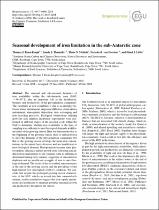JavaScript is disabled for your browser. Some features of this site may not work without it.
- ResearchSpace
- →
- Research Publications/Outputs
- →
- Journal Articles
- →
- View Item
| dc.contributor.author |
Ryan-Keogh, Thomas J

|
|
| dc.contributor.author |
Thomalla, Sandy J

|
|
| dc.contributor.author |
Mtshali, Thato N

|
|
| dc.contributor.author |
Van Horsten, Natasha R

|
|
| dc.contributor.author |
Little, HJ

|
|
| dc.date.accessioned | 2019-04-03T06:26:22Z | |
| dc.date.available | 2019-04-03T06:26:22Z | |
| dc.date.issued | 2018-07 | |
| dc.identifier.citation | Ryan-Keogh, T.J. et al. 2018. Seasonal development of iron limitation in the sub-Antarctic zone. Biogeosciences, vol. 15: 4647-4660 | en_US |
| dc.identifier.issn | 1726-4170 | |
| dc.identifier.issn | 1726-4189 | |
| dc.identifier.uri | https://doi.org/10.5194/bg-15-4647-2018 | |
| dc.identifier.uri | https://www.biogeosciences.net/15/4647/2018/ | |
| dc.identifier.uri | http://hdl.handle.net/10204/10914 | |
| dc.description | © Author(s) 2018. This work is distributed under the Creative Commons Attribution 4.0 License. | en_US |
| dc.description.abstract | The seasonal and sub-seasonal dynamics of iron availability within the sub-Antarctic zone (SAZ; 40–45 degees) play an important role in the distribution, biomass and productivity of the phytoplankton community. The variability in iron availability is due to an interplay between winter entrainment, diapycnal diffusion, storm-driven entrainment, atmospheric deposition, iron scavenging and iron recycling processes. Biological observations utilizing grow-out iron addition incubation experiments were performed at different stages of the seasonal cycle within the SAZ to determine whether iron availability at the time of sampling was sufficient to meet biological demands at different times of the growing season. Here we demonstrate that at the beginning of the growing season, there is sufficient iron to meet the demands of the phytoplankton community, but that as the growing season develops the mean iron concentrations in the mixed layer decrease and are insufficient to meet biological demand. Phytoplankton increase their photosynthetic efficiency and net growth rates following iron addition from midsummer to late summer, with no differences determined during early summer, suggestive of seasonal iron depletion and an insufficient resupply of iron to meet biological demand. The result of this is residual macronutrients at the end of the growing season and the prevalence of the high-nutrient low-chlorophyll (HNLC) condition. We conclude that despite the prolonged growing season characteristic of the SAZ, which can extend into late summer/early autumn, results nonetheless suggest that iron supply mechanisms are insufficient to maintain potential maximal growth and productivity throughout the season. | en_US |
| dc.language.iso | en | en_US |
| dc.publisher | Copernicus GmbH | en_US |
| dc.relation.ispartofseries | Worklist;22299 | |
| dc.subject | Sub-Antarctic zone | en_US |
| dc.subject | Sub-seasonal dynamics | en_US |
| dc.subject | Phytoplankton communities | en_US |
| dc.subject | Seasonal development | en_US |
| dc.title | Seasonal development of iron limitation in the sub-Antarctic zone | en_US |
| dc.type | Article | en_US |
| dc.identifier.apacitation | Ryan-Keogh, T. J., Thomalla, S. J., Mtshali, T. N., Van Horsten, N. R., & Little, H. (2018). Seasonal development of iron limitation in the sub-Antarctic zone. http://hdl.handle.net/10204/10914 | en_ZA |
| dc.identifier.chicagocitation | Ryan-Keogh, Thomas J, Sandy J Thomalla, Thato N Mtshali, Natasha R Van Horsten, and HJ Little "Seasonal development of iron limitation in the sub-Antarctic zone." (2018) http://hdl.handle.net/10204/10914 | en_ZA |
| dc.identifier.vancouvercitation | Ryan-Keogh TJ, Thomalla SJ, Mtshali TN, Van Horsten NR, Little H. Seasonal development of iron limitation in the sub-Antarctic zone. 2018; http://hdl.handle.net/10204/10914. | en_ZA |
| dc.identifier.ris | TY - Article AU - Ryan-Keogh, Thomas J AU - Thomalla, Sandy J AU - Mtshali, Thato N AU - Van Horsten, Natasha R AU - Little, HJ AB - The seasonal and sub-seasonal dynamics of iron availability within the sub-Antarctic zone (SAZ; 40–45 degees) play an important role in the distribution, biomass and productivity of the phytoplankton community. The variability in iron availability is due to an interplay between winter entrainment, diapycnal diffusion, storm-driven entrainment, atmospheric deposition, iron scavenging and iron recycling processes. Biological observations utilizing grow-out iron addition incubation experiments were performed at different stages of the seasonal cycle within the SAZ to determine whether iron availability at the time of sampling was sufficient to meet biological demands at different times of the growing season. Here we demonstrate that at the beginning of the growing season, there is sufficient iron to meet the demands of the phytoplankton community, but that as the growing season develops the mean iron concentrations in the mixed layer decrease and are insufficient to meet biological demand. Phytoplankton increase their photosynthetic efficiency and net growth rates following iron addition from midsummer to late summer, with no differences determined during early summer, suggestive of seasonal iron depletion and an insufficient resupply of iron to meet biological demand. The result of this is residual macronutrients at the end of the growing season and the prevalence of the high-nutrient low-chlorophyll (HNLC) condition. We conclude that despite the prolonged growing season characteristic of the SAZ, which can extend into late summer/early autumn, results nonetheless suggest that iron supply mechanisms are insufficient to maintain potential maximal growth and productivity throughout the season. DA - 2018-07 DB - ResearchSpace DP - CSIR KW - Sub-Antarctic zone KW - Sub-seasonal dynamics KW - Phytoplankton communities KW - Seasonal development LK - https://researchspace.csir.co.za PY - 2018 SM - 1726-4170 SM - 1726-4189 T1 - Seasonal development of iron limitation in the sub-Antarctic zone TI - Seasonal development of iron limitation in the sub-Antarctic zone UR - http://hdl.handle.net/10204/10914 ER - | en_ZA |






